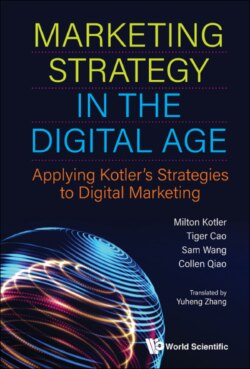Читать книгу Marketing Strategy In The Digital Age: Applying Kotler's Strategies To Digital Marketing - Milton Kotler - Страница 28
На сайте Литреса книга снята с продажи.
1.1.4 Social business model in the 21st century
ОглавлениеThe United States has made a rough calculation of the productivity effect brought by the information wave. In the personal computer era, IT contributed 40% to the US GDP. In the Internet and Web 1.0 era, the overall productivity of the United States increased by 2.75%. The contribution of technology to GDP has increased to around 50%. In the era of Web 2.0 and mobile Internet, the total value of production will be up to 60%. How did the business model under this new social wave come about?
Professor John Dayton of Harvard Business School attributed the 20th century business model to three forces, which together shaped consumer purchases in 20th century: transportation, shopping centers and television networks. The growth of the American railways in the late 19th century helped in connecting many cities and villages. The smooth flow of transportation brought about the possibility of boom for shopping malls, which effectively gathered a large number of dispersed people at one point. In 1892, a train agent in Minnesota, Richard Sears, saw the capacity of the North American railway and its commercial potential and began to provide goods to farmers and other people who could not easily reach the city; ultimately, his vision helped him create the famous Sears Retail.
The increase in the number of TV commercials has stimulated and shaped people’s shopping behavior. In China alone, note how many enterprises, 20 years ago, made a fortune through TV advertisements and sold their products across the nation overnight. Transportation, TV networks and shopping centers is a three-in-one working model. The TV network stimulates the desires and the group behavior of branding. The wide layout of the shopping center enables massive purchases. In essence, all three are to eliminate the distance between goods and consumers through connections and to facilitate the completion of transactions.
What is the difference in the business model of the 21st century? John Dayton also attributed it to three other forces: mobile search, social networking and e-commerce. Mobile search solves the consumer’s initiative to capture information, accessing resources that were previously unavailable and comparable at any time and place; social networks enable consumers to evaluate goods and services and consumers no longer rely on original TV ads. More from word-of-mouth effect, community effect and more accurate information from connected groups; e-commerce realizes the separation between goods and people. People can compare prices, read comments and read the opinions posted online. The three power restructures the business model of the 21st century (Figure 1.5).
Figure 1.5. Two business models.
Source: Professor John Dayton.
